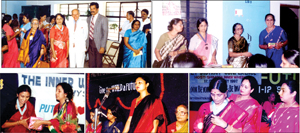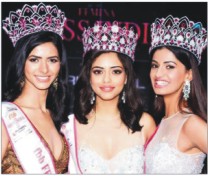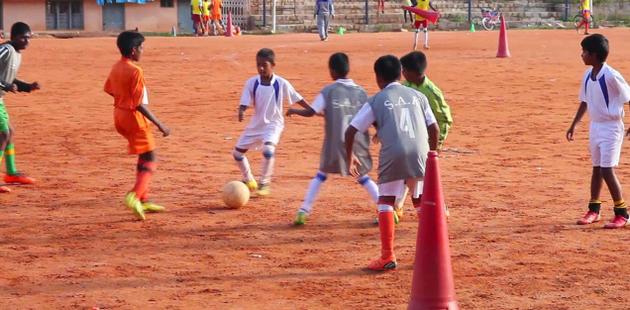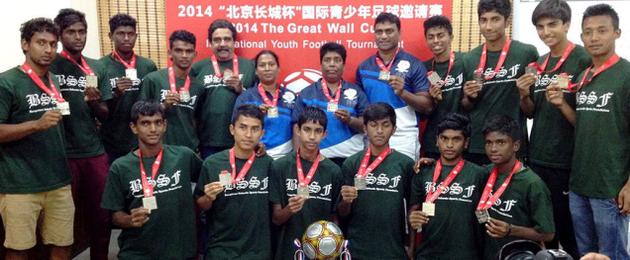The Inner Wheel Club of Mysore has completed 50 years of Service and Friendship to the society.
To mark its Golden Jubilee Year [1966-2016], the members of the Club have taken up various projects like construction of toilets for school children, an organ donation awareness camp and Swachh Bharat Abhiyan during the year.
Here we publish an article by Naina Achappa, Past District Chairman of Inner Wheel District 318, who goes down the memory lane, unravelling the history and glory of this all-women Club. Now read on. —Ed.
by Naina Achappa
Talking about beautiful memories always ignites a spark of curiosity among those we meet and greet. For some of us, being a part of these memories and a part of its glory as well, created a feeling of ecstasy when walking down the memory lane and unravelling the history and glory of this wonderful club — Inner Wheel Club of Mysore — which is celebrating its Golden Jubilee this year – 2016.
It was in the year 1966 that late Rotarian N.N Shastry of the Rotary Club of Mysore decided to bring the wives of Rotarians together to form the First Inner Wheel Club of Mysore. It had the support of the Rotarians of the Club, the dynamic presence of late Farook Irani, whose live wire qualities was a source of encouragement motivating the ladies to form the Club. Rtn. P.R. Sitaram was also instrumental in taking the initiative to start the Club.
International Inner Wheel had already been formed in 1923 by Mrs. Oliver Golding in Manchester, United Kingdom, with the motto “Friendship and Service.” In due course of time many Clubs started in England and spread to other countries like Australia, New Zealand, Canada, Norway and Africa, where service to humanity was in great need. The first Club in India, The Inner Wheel Club of Ahmedabad, was established in 1955 and it spread to other parts of the country as well. Soon an Association was formed in each country and Clubs were grouped into Districts. In 1962, International Inner Wheel for the first time invited members from other countries to sit on the Governing Board and by 1967, the prestigious role of International Inner Wheel President was thrown open to elections for any qualified member from any country to participate in. It’s, therefore, with great honour that we look upon the 5 International Presidents from India till date.
On the occasion of the Golden Jubilee celebrations, I would like to pay tribute to the 50 Presidents of this Club for the time and energy they invested in us. ‘Wipe a tear and bring a smile to the faces of those that need our help and there can be no time better spent,’ this belief is what drove us for decades helping us weave a beautiful tapestry of the years gone by. A feeling of nostalgia set in and I couldn’t help but pen my thoughts. For many a times, the pleasure comes from the journey and not the destination.
The Inner Wheel Club of Mysore was inaugurated on 28th February 1966 with Pramila Krishna as Charter President and Seetha Kaveriappa as the Charter Secretary. Sheila Irani and Shantha Rao were elected as Vice-Presidents. Binnie Nanaiah was the Treasurer. The core team was formed by Vimala Krishna Rao, Lalitha Sitaram, Ratnamma Shastry, Sumitra Gopal Rao, Susheela Krishnamurthy, Sundramma Narayanaswamy, Damayanthi Rao and Thangamma Subba Rao. The procedure of functioning was full of dignity and grace, the decorum and propriety always in order and the ladies took great pride in learning from each other. Even today Charter members are held in high esteem.
Service was given major importance and projects revolved around the Cheluvamba Hospital for Women and Children. Members visited the hospital every week and counselled women and young mothers. Food packets and medicines (iron and calcium tablets), baby clothes and other baby products were distributed. They inspected the toilets and wards and ensured cleanliness. The Leper Colony on Nanjangud Road was another major project which continued till 2002. The Lepers were treated and bandage distribution houses were built by our members’ donation and maintenance work was done year after year. As a part of our contribution towards environmental conservation, trees were planted in many parks and along the road sides in Mysore.
In keeping with the motto of Friendship, meetings were often unofficial and were arranged in each other’s homes. Dinners were arranged and every host took great pride in displaying the best of their crockery and cutlery. It was over those dinner conversations that we bonded and forged relationships that would last a life time. Needless to say, it is with great fondness and satisfaction that we look upon the small difference we could make in making our world a better place.
A membership of just 12 members at Charter Presentation grew to 19 members (see pic).
Every year it progressed rapidly. It’s wonderful to say that we are the only Club in our District and perhaps in the whole of the nation as well, to have had 12 District Chairmen from one Club. It surely is an extra feather in our cap. Hence, on the side note, I felt it apt to highlight on the past District Chairmen of the Club and add essence to its 50 years of existence.
The late Sheila Irani was the first member from our Club to become the District Chairman of District 318 in the year 1970-71. She was an example of an outstanding Woman of Substance whose leadership qualities and comradeship was a learning ground for all the members who crossed her path. There was order and system in everything she did and she set an example for all of us to follow. She was a wonderful leader and taught members some simple intricacies of life which is often a topic of discussion among us even today. We also had the honour of having the International President Agnes Bulpitt visit our Club in 1973. It was a moment of pride for all the members. Sheila Irani was actively associated with the Inner Wheel Movement worldwide and attended many International Conventions as well. Her popularity soared and soon she became the Association President of Inner Wheel Clubs in India in the year 1980-81. A gala function was arranged at the Gun House Imperial Hotel in Mysuru and members from all over India attended it. The Palace Band was in full attendance and late Farook Irani and Sheila Irani played perfect hosts to an evening of pomp and splendour. A sit-down dinner in all its finery was accorded to the guests and was indeed the talk of the town.
It was again in the year 1974-75 that another member from our Club late Lalitha Sitaram became the District Chairman. She was a dedicated member whose love for the Rule Book always took prominence in all that she said and did. She taught us the importance of a system and was always a guide and mentor to us. She is fondly remembered even today for her advice and affection towards members.
Inner Wheel District 318 spread around the Revenue Districts of Mysore and soon a bifurcation of the District was necessary. Bangalore Clubs grouped into District 319 and Inner Wheel Club of Mysore came to be the First Club in District 318 with many Clubs from Mangalore, Shimoga, Hassan and Chikmagalur joining together to form a strong District. It was an important turning point for us and interesting leaders emerged. Inner Wheel Club of Mysore was always at the run in District affairs.
In 1980-81, late Meena Sanath became the District Chairman. A jovial, happy person, her infectious friendliness and sincerity always encouraged us to come to the forefront and set the road for the development of leading the District. The teacher ,in her, always emerged and her happy spirit prevailed. The year 1985-86 again was an important year for our Club as Sharada Alva became the District Chairman. A strong and determined person, her interests in abolition of the dowry system spread across the District and motivated members to work towards it. She conducted an interior decoration class for the first time and Hotel Highway sponsored the one-week programme free of cost. A good sum of money was collected for our projects.
After a gap of one year, 1987-88 saw the soft-spoken late Veena Bapat become the District Chairman. An active member of Vivekananda Kendra, her interests in yoga and service to people made her a devout leader. She was a knowledgeable person, who devoted her time and energy to bring about a change in the lives of the poor and needy.
The Club had grown considerably in membership and many Clubs sprang up in the city of Mysore. It was in 1989-90 that the gentle and soft-spoken Binnie Nanaiah became the District Chairman. An active Charter Member, her guidance is respected even today. Her love for poetry always found a place in the Club and District Bulletins and she continues to be with us as often as she can, which is appreciable.
It is really wonderful to know that our Club was always at the top of the District. In 1993-94, the charming and pretty. Geetha Kuttappa was elected District Chairman. A good speaker and a talented singer, she was always popular among the ladies in the District.
Saroja Ramu became the District Chairman in the year 1996-97. A simple and friendly person, she managed her profession and Inner Wheel with composure and patience. She was a silent worker who strived hard for the success of the Club.
It was in 1998-99 that late Geetha Ravikumar became the District Chairman. A leader par excellence, an extremely talented person with a never say never attitude, she led the Club in all its activities, be it organising a function or doing a project, her spirit in doing whatever she did with perfection, still remains a strong memory for all of our members who knew her. I would like to say I learnt so much from her and she still remains in my heart as a mentor and guide and above all a great friend. Never is a day in any of our celebrations complete without speaking of her rangoli, flower arrangements and decoration. She will remain with us forever.
The year 2000-01 was the year that the cheerful and lovely Jannavi Murthy took over as District Chairman. For the first time, our District hosted the Chairman’s Institute in Mysore, an important event of the Association, and brought laurels to our Club and the District. Our organisational skills were put to test and we did a wonderful job. The District Conference was a celebration of sorts with famous Novelist and Women Activist Shobhaa De as the chief guest. It was a day to remember.
After a gap of four years, again we at our Club had Yours Truly, Naina Achappa as the District Chairman. For me, it was indeed a great experience for I had to make speeches in Kannada in some of the rural Clubs. It was a great learning experience. It also made me realise that nothing is impossible in this world. The District Conference was at the Lalitha Mahal Palace Hotel and Anitha Rathnam, an accomplished Indian Classical and Contemporary dancer and Cultural Activist, was the chief guest. We also had the honour of having the International President Erna Fandal visit Mysore and all the Inner Wheel Clubs of Mysore joined in the celebrations.
Donning the role of the 12th District Chairman was the compassionate and capable Swarna Chittaranjan. Her involvement at the District-level with hard work and commitment won her the well-deserved role of District Chairman. Even today she actively participates in all District activities. Her District Conference at Mysore had popular humorist Sudha Bargur, adding flavour to the celebrations, as the chief guest.
Today as we join together with a membership of 60 women, I would like to say “Inner Wheel has given me wonderful friends and the great joy of being useful to society.” Projects worth lakhs of rupees like medical care for the needy, heart operations, food, clothing and comfort to Old-age Homes, help to the Blind, Disabled and Spastic, Artificial limb donation, Eye donation support and care, Building toilets for school children… Yet there is so much to be done and will continue to be done by the members in the years to come.
Projects launched on the occasion of the Golden Jubilee celebrations are Swachh Bharat Abhiyaan and Organ Donation Awareness Camp.
Finally, I would like to say, this Golden Jubilee Year is indeed a celebration of Womanhood of the 50 Presidents and each and every member of the Club who joined hands in giving LIFE to the word SERVICE…This is a story of women, written by women, for women, about women, not famous or outstanding women… just women, who for half-a-century have made FRIENDSHIP their target and SERVICE their goal. May God give us the spirit to continue for ever.
source: http://www.starofmysore.com / Star of Mysore / Home> Feature Articles / April 18th, 2016

![1) Y. G. Krishnamurti [17.2.1916 - 19.1.1977] 2) From left : Nehru’s sister Krishna Hutheesing, S. Radhakrishnan, First CJI - Pathanjali Sastry & YGK.](http://www.bangalorefirst.in/wp-content/uploads/2016/04/KrishnamurthiBF16apr2016.jpg)






